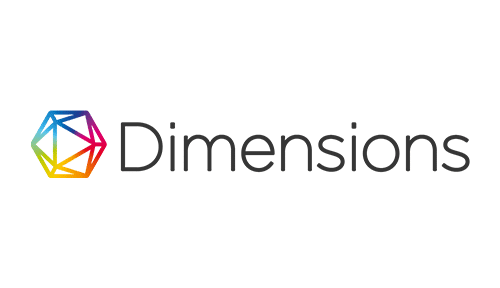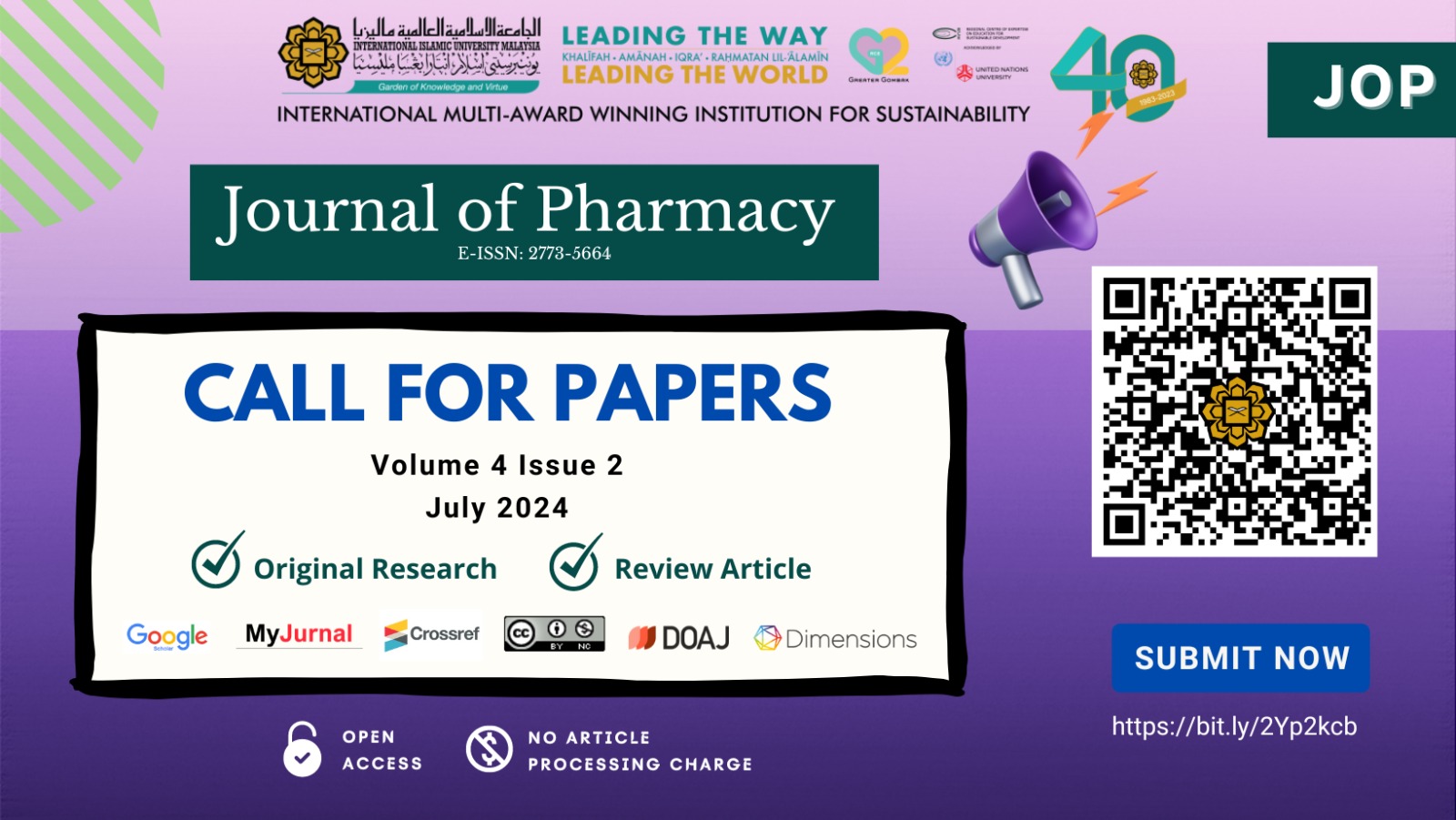Potential Nanospray Inhalation of Remdesivir and Hydroxychloroquine using Poly (lactic-co-glycolic) Acid as Fast Delivery for Covid-19 Treatment.
DOI:
https://doi.org/10.31436/jop.v1i1.50Keywords:
COVID-19, nanospray, hydroxychloroquine, remdesivir, inhalation, antiviralAbstract
Introduction: The oral medication of remdesivir and hydroxychloroquine face several limitations in covid-19 therapy. Despite having the first-pass metabolism, it also has a limitation in the patient who has hospitalised with a severe covid-19 infection. It is especially for a drug that is targeting the angiotensin-converting enzyme II (ACE2) receptor where the receptors are found abundantly in the lung, kidney, heart, and gastrointestinal tract. Therefore, an alternative delivery such as nanospray inhalation would provide a great benefit to those patients.
Methods: Scientific sources from Scopus, PubMed, Google Scholar, EBSCO, ScienceDirect, and Elsevier were accessed for publication of this review article regarding the nanospray inhalation for Covid-19.
Results: Since the main organ infected by SARS-CoV-2 is the trachea and lung, inhalation may be the best route to deliver the drug to the site of action. It is proposed that poly (lactic-co-glycolic) acid to be used in the formulation.
Conclusion: Poly (lactic-co-glycolic) acid (PLGA) is considered a suitable polymer since it is biocompatible and noncytotoxic, it is the most widely applied in drug delivery either as carrier or excipient for the optimal formulation and distribution of the drugs. Dry powder inhalation of remdesivir and hydroxychloroquine may be an alternative way to deliver the drug against Covid-19.
References
Ahmad, M. I., Ungphaiboon, S., & Srichana, T. (2015). The development of dimple-shaped chitosan carrier for ethambutol dihydrochloride dry powder inhaler. Drug Development and Industrial Pharmacy, 41(5), 791–800. https://doi.org/10.3109/03639045.2014.903493
Al-Tawfiq, J. A., Al-Homoud, A. H., & Memish, Z. A. (2020). Remdesivir as a possible therapeutic option for the COVID-19. Travel Medicine and Infectious Disease, 101615. https://doi.org/10.1016/j.tmaid.2020.101615
Amsalem, O., Nassar, T., Benhamron, S., Lazarovici, P., Benita, S., & Yavin, E. (2017). Solid nano-in-nanoparticles for potential delivery of siRNA. Journal of Controlled Release, 257, 144–155. https://doi.org/10.1016/j.jconrel.2016.05.043
Arpagaus, C. (2012). A Novel Laboratory-Scale Spray Dryer to Produce Nanoparticles. Drying Technology, 30(10), 1113–1121. https://doi.org/10.1080/07373937.2012.686949
Arpagaus, C. (2018). Pharmaceutical Particle Engineering via Nano Spray Drying -Process Parameters and Application Examples on the Laboratory-Scale. International Journal of Medical Nano Research, 5(1), 1–15. https://doi.org/10.23937/2378-3664.1410026
Arpagaus, C. (2019a). Nanoparticles of PLA / PLGA Biopolymers prepared by Nano Spray Drying. Proceedings of Eurodrying, 10–12(July), 1–9.
Arpagaus, C. (2019b). PLA/PLGA nanoparticles prepared by nano spray drying. Journal of Pharmaceutical Investigation, 49(4), 405–426. https://doi.org/10.1007/s40005-019-00441-3
Arpagaus, C., Collenberg, A., Rütti, D., Assadpour, E., & Jafari, S. M. (2018). Nano spray drying for encapsulation of pharmaceuticals. International Journal of Pharmaceutics, 546(1–2), 194–214. https://doi.org/10.1016/j.ijpharm.2018.05.037
Arpagaus, C., & Meuri, M. (2010). Laboratory Scale Spray Drying of Inhalable Drugs: A Review. Respiratory Drug Delivery, 59, 1–8.
Barrett, E. G., Rudolp, K., Raff, H., & Charous, B. L. (2008). Nasal hydroxychloroquine (HCQ) decreases nasal congestion and inhibits mediator release after regweed challenge in sensitized beagle dogs. Journal of Allergyand Clinical Immunology, 121(2), S277. https://doi.org/10.1016/j.jaci.2010.12.881
Bartolucci, M. J. (2017). A Poly ( Lactic Co Glycolic ) Acid Based Dry Powder Inhaler for the Treatment of Pulmonary Tuberculosis. (Master Thesis, Harvard University). Harvard Library.Retrieved from http://nrs.harvard.edu/urn-3:HUL.InstRepos:37736755
Beck-Broichsitter, M., Schweiger, C., Schmehl, T., Gessler, T., Seeger, W., & Kissel, T. (2012). Characterization of novel spray-dried polymeric particles for controlled pulmonary drug delivery. Journal of Controlled Release, 158(2), 329–335. https://doi.org/10.1016/j.jconrel.2011.10.030
Blasi, P. (2019). Poly(lactic acid)/poly(lactic-co-glycolic acid)-based microparticles: an overview. Journal of Pharmaceutical Investigation,49(4), 337–346. https://doi.org/10.1007/s40005-019-00453-z
Bouadma, L., Lescure, F. X., Lucet, J. C., Yazdanpanah, Y., & Timsit, J. F. (2020). Severe SARS-CoV-2 infections: practical considerations and management strategy for intensivists. Intensive Care Medicine, 46(4), 579–582. https://doi.org/10.1007/s00134-020-05967-x
Colson, P., Rolain, J. M., & Raoult, D. (2020). Chloroquine for the 2019 novel coronavirus SARS-CoV-2. International Journal of Antimicrobial Agents. https://doi.org/10.1016/j.ijantimicag.2020.105923
Covid-19 Visualiser. (2020). Retrieved from http://www.covidvisualizer.com
Danhier, F., Ansorena, E., Silva, J. M., Coco, R., Le Breton, A., & Préat, V. (2012). PLGA-based nanoparticles: An overview of biomedical applications. Journal of Controlled Release, 161(2), 505–522. https://doi.org/10.1016/j.jconrel.2012.01.043
Eastman, R. T., Roth, J. S., Brimacombe, K. R., Simeonov, A., Shen, M., Patnaik, S., & Hall, M. D. (2020). Remdesivir: A review of its discovery and development leading to human clinical trials for treatment of COVID-19. Preprints, April,1–20. https://doi.org/10.20944/preprints201810.0478.v1
Essa, D., Kondiah, P. P. D., Choonara, Y. E., & Pillay, V. (2020). The Design of Poly(lactide-co-glycolide) Nanocarriers for Medical Applications. Frontiers in Bioengineering and Biotechnology, 8(February), 1–20. https://doi.org/10.3389/fbioe.2020.00048
Gao, J., Tian, Z., & Yang, X. (2020). Breakthrough: Chloroquine phosphate has shown apparent efficacy in treatment of COVID-19 associated pneumonia in clinical studies. BioScience Trends, 14(1), 72–73. https://doi.org/10.5582/BST.2020.01047
Gaurav, J., & Ramarao, P. (2020). Virtual Screening Enabled Selection of Antiviral Agents Against Covid-19 Disease Targeting Coronavirus Endoribonuclease NendoU: Plausible Mechanistic Interventions in the Treatment of New Virus Strain. ChemRxiv, 00876, 1–22. https://doi.org/10.26434/chemrxiv.12198966.v1
Gordon, C. J., Tchesnokov, E. P., Woolner, E., Perry, J. K., Feng, J. Y., Porter, D. P., & Gotte, M. (2020).Remdesivir is a direct-acting antiviral that inhibits RNA-dependent RNA polymerase from severe acute respiratory syndrome coronavirus 2 with high potency. Journal of Biological Chemistry, 1–26. https://doi.org/10.1074/jbc.ra120.013679
Guo, Y. R., Cao, Q. D., Hong, Z. S., Tan, Y. Y., Chen, S. D., Jin, H. J., ...Yan, Y. (2020). The origin, transmission and clinical therapies on coronavirus disease 2019 (COVID-19) outbreak-An update on the status. Military Medical Research, 7(1), 1–10. https://doi.org/10.1186/s40779-020-00240-0
Haggag, Y. A., & Faheem, A. M. (2015). Evaluation of nano spray drying as a method for drying and formulation of therapeutic peptides and proteins. Frontiers in Pharmacology, 6(JUL), 1–5. https://doi.org/10.3389/fphar.2015.00140
Hirenkumar, M., & Steven, S. (2012). Poly Lactic-co-Glycolic Acid (PLGA) as Biodegradable Controlled Drug Delivery Carrier. Polymers, 3(3), 1–19. https://doi.org/10.3390/polym3031377.Poly
Holshue, M. L., DeBolt, C.,Lindquist, S., Lofy, K. H., Wiesman, J., Bruce, H., ... Pillai, S. K. (2020). First case of 2019 novel coronavirus in the United States. New England Journal of Medicine, 382(10), 929–936. https://doi.org/10.1056/NEJMoa2001191
Itani, R., Tobaiqy, M., & Faraj, A. Al. (2020). Optimizing use of theranostic nanoparticles as a life-saving strategy for treating COVID-19 patients. Theranostics, 10(13), 5932–5942. https://doi.org/10.7150/thno.46691
Karathanasis, E., Ayyagari, A. L., Bhavane, R., Bellamkonda, R. V., &Annapragada, A. V. (2005). Preparation of in vivo cleavable agglomerated liposomes suitable for modulated pulmonary drug delivery. Journal of Controlled Release, 103(1), 159–175. https://doi.org/10.1016/j.jconrel.2004.11.009
Ko, W., Rolain, J., Lee, N., Chen, P., & Huang, C. (2020). Arguments in favour of remdesivir for treating SARS-CoV-2 infections.International Journal of Antimicrobial Agents, 55(4), 105933. https://doi.org/10/1016/j.ijantimicag.2020.105933
Liu, J., Cao, R., Xu, M., Wang, X., Zhang, H., Hu, H., ... Wang, M. (2020). Hydroxychloroquine, a less toxic derivative of chloroquine, is effective in inhibiting SARS-CoV-2 infection in vitro. Cell Discovery, 6(1), 6–9. https://doi.org/10.1038/s41421-020-0156-0
Moore, N. (2020). Chloroquine for COVID-19 Infection. Drug Safety, 43(5), 393–394. https://doi.org/10.1007/s40264-020-00933-4
Morse, J. S., Lalonde,T., Xu, S., & Liu, W. R. (2020). Learning from the Past: Possible Urgent Prevention and Treatment Options for Severe Acute Respiratory Infections Caused by 2019-nCoV. ChemBioChem, 21(5), 730–738. https://doi.org/10.1002/cbic.202000047
O’Neill, P. M., Bray, P. G., Hawley, S. R., Ward, S. A., & Kevin Park, B. (1998). 4-Aminoquinolines -Past, present, and future: A chemical perspective. Pharmacology and Therapeutics, 77(1), 29–58. https://doi.org/10.1016/S0163-7258(97)00084-3
Panati, K., & Narala, V. R. (2020). COVID-19 Outbreak: an Update on Therapeutic Options. SN Comprehensive Clinical Medicine, 3–4. https://doi.org/10.1007/s42399-020-00264-6
Pandey, A., & Jain, D. S. (2015). Poly Lactic-Co-Glycolic Acid (PLGA) Copolymer and Its Pharmaceutical Application.Handbook of Polymers for Pharmaceutical Technologies, 2, 151–172. https://doi.org/10.1002/9781119041412.ch6
Patrizia, A. R., Mariateresa, S., Pasquale, D. G., Teresa, M., Francesca, S., & Paola, R. (2014). Nanospray Drying as a Novel Technique for the Manufacturing of Inhalable NSAID Powders. Scientific World Journal, 2014, 1–8. https://doi.org/10.1155/2014/838410
Schafroth, N., Arpagaus, C., Jadhav, U. Y., Makne, S., & Douroumis, D. (2012). Nano and microparticle engineering of water insoluble drugs usinga novel spray-drying process. Colloids and Surfaces B: Biointerfaces, 90(1), 8–15. https://doi.org/10.1016/j.colsurfb.2011.09.038
She, J., Jiang, J., Ye, L., Hu, L., Bai, C., & Song, Y. (2020). 2019 novel coronavirus of pneumonia in Wuhan, China: emergingattack and management strategies. Clinical and Translational Medicine, 9(1). https://doi.org/10.1186/s40169-020-00271-z
Sheahan, T. P., Sims, A. C., Graham, R. L., Menachery, V. D., Gralinski, L. E., Case, J. B.,... Baric, R. S. (2017). Broad-spectrum antiviral GS-5734 inhibits both epidemic and zoonotic coronaviruses. Science Translational Medicine, 9(396), 1–11. https://doi.org/10.1126/scitranslmed.aal3653
Singh, A. K., Singh, A., Shaikh, A., Singh, R., & Misra, A. (2020). Chloroquine and hydroxychloroquine in the treatment of COVID-19 with or without diabetes: A systematic search and a narrative review with a special reference to India and other developing countries. Diabetes and Metabolic Syndrome: Clinical Research and Reviews, 14(3), 241–246. https://doi.org/10.1016/j.dsx.2020.03.011
Swider, E., Koshkina, O., Tel, J., Cruz, L. J., de Vries, I. J. M., & Srinivas, M. (2018). Customizing poly(lactic-co-glycolic acid) particles for biomedical applications. Acta Biomaterialia, 73, 38–51. https://doi.org/10.1016/j.actbio.2018.04.006
Thomé, R., Lopes, S. C. P., Costa, F. T. M., & Verinaud, L.(2013). Chloroquine: Modes of action of an undervalued drug. Immunology Letters, 153(1–2), 50–57. https://doi.org/10.1016/j.imlet.2013.07.004
Ungaro, F., D’Angelo, I., Miro, A., La Rotonda, M. I., & Quaglia, F. (2012). Engineered PLGA nano-and micro-carriers for pulmonary delivery: Challenges and promises. Journal of Pharmacy and Pharmacology, 64(9), 1217–1235. https://doi.org/10.1111/j.2042-7158.2012.01486.x
Wang, M., Cao, R., Zhang, L., Yang, X., Liu, J., Xu, M., ... Xiao, G. (2020). Remdesivir and chloroquine effectively inhibit the recently emerged novel coronavirus (2019-nCoV) in vitro. Cell Research, 30(3), 269–271. https://doi.org/10.1038/s41422-020-0282-0
Warhurst, D.C., Steele, J. C. P., Adagu, I. S., Craig, J. C., & Cullander, C. (2003). Hydroxychloroquine is much less active than chloroquine against chloroquine-resistant Plasmodium falciparum, in agreement with its physicochemical properties. Journal of Antimicrobial Chemotherapy, 52(2), 188–193. https://doi.org/10.1093/jac/dkg319
Yang, P., & Wang, X. (2020). COVID-19: a new challenge for human beings. Cellular and Molecular Immunology, March, 19–21. https://doi.org/10.1038/s41423-020-0407-x
Zhang, T., He, Y., Xu, W., Ma, A., Yang, Y., & Xu, K. F. (2020). Clinical trials for the treatment of Coronavirus disease 2019 (COVID-19): A rapid response to urgent need. Science China Life Sciences, 63(5), 774–776. https://doi.org/10.1007/s11427-020-1660-2
Zhou, G., Chen, S., &Chen, Z. (2020a). Back to the spring of Wuhan: facts and hope of COVID-19 outbreak.Frontiers of Medicine, 1–4. https://doi.org/10.1007/s11684-020-0758-9
Zhou, M., Zhang, X., & Qu, J. (2020). Coronavirus disease 2019 (COVID-19): a clinical update. Frontiers of Medicine, 2019. https://doi.org/10.1007/s11684-020-0767-8
Downloads
Published
How to Cite
Issue
Section
License
Copyright (c) 2020 Journal of Pharmacy

This work is licensed under a Creative Commons Attribution 4.0 International License.
Journal of Pharmacy at https://journals.iium.edu.my/ktn/index.php/jp is licensed under a Creative Commons Attribution 4.0 International License.












